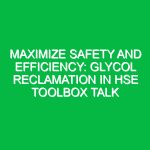Introduction
Personal Protective Equipment (PPE) is a critical component in the realm of Health, Safety, and Environment (HSE). But what does PPE mean in this context? Essentially, PPE refers to protective gear designed to safeguard individuals from various hazards that can cause injuries or illnesses in the workplace. This equipment is not just about compliance; it embodies a culture of safety that prioritizes the well-being of employees and the environment.
In an age where workplace safety is paramount, understanding the implications of PPE within HSE practices is essential. With the rising awareness of occupational hazards and environmental concerns, the relevance of PPE has never been more pronounced. This article aims to delve into the nuances of what PPE means in the HSE domain, exploring its components, importance, regulations, and best practices to ensure a safer working environment.
Understanding PPE: Definitions and Components
PPE encompasses a wide array of protective gear, including but not limited to:
- Hard hats
- Safety goggles
- Respirators
- Ear protection
- Gloves
- Protective clothing
- Foot protection
Each of these items serves a specific purpose, addressing different types of risks. For instance, safety goggles protect against flying debris, while respirators guard against inhaling harmful substances. The selection of appropriate PPE is crucial, as it directly correlates with the type of hazards present in the workplace.
The Importance of PPE in HSE
Understanding what PPE means in the context of HSE goes beyond just the equipment itself; it embodies a proactive approach to workplace safety. The importance of PPE can be highlighted through several key aspects:
1. Risk Mitigation
PPE is designed to reduce the risk of injury or illness. In environments where workers are exposed to physical, chemical, or biological hazards, the right protective gear can significantly decrease the likelihood of accidents. For instance, in a construction site, wearing a hard hat can prevent serious head injuries from falling objects.
2. Legal Compliance
Various regulations govern the use of PPE. Organizations are often legally required to provide appropriate protective equipment to their employees. Failure to comply can result in severe penalties, including fines and legal action. Understanding what PPE means in the HSE context is essential for ensuring compliance with such regulations.
3. Promoting a Safety Culture
The use of PPE fosters a culture of safety within organizations. When employees see that their safety is prioritized through the provision of adequate protective gear, it enhances their sense of security and encourages adherence to safety protocols. This cultural shift is vital for maintaining a safe working environment.
Components of PPE: What Does PPE Mean in Practice?
Understanding what PPE means in practice involves recognizing the specific types of equipment and their appropriate uses. Each category of PPE plays a distinct role in protecting workers from various hazards.
1. Head Protection
Head protection is vital in industries like construction and manufacturing. Hard hats are designed to absorb impact from falling objects, reducing the risk of head injuries. It’s essential for employers to ensure that hard hats meet specific safety standards, such as those set by the American National Standards Institute (ANSI).
2. Eye and Face Protection
Safety goggles and face shields protect workers from chemical splashes, flying debris, and harmful radiation. Employees working in laboratories or welding environments should always wear appropriate eye and face protection to prevent serious injuries.
3. Respiratory Protection
Respirators are crucial for workers exposed to airborne contaminants. In industries such as painting, construction, and healthcare, proper respiratory protection can prevent serious health problems. Employers must conduct a hazard assessment to determine the type of respirator needed for specific tasks.
4. Hearing Protection
Noise-induced hearing loss is a significant risk in many workplaces. Earplugs and earmuffs can protect employees from harmful noise levels. Employers should provide hearing protection to workers in environments where noise exceeds recommended exposure limits.
5. Hand Protection
Gloves are essential for protecting hands from chemicals, cuts, and burns. Different types of gloves are designed for specific tasks, such as chemical-resistant gloves for handling hazardous materials or cut-resistant gloves for jobs involving sharp objects.
6. Foot Protection
Safety boots with steel toes protect feet from heavy objects and punctures. In environments with potential foot injuries, such as warehouses or construction sites, wearing appropriate footwear is crucial for ensuring worker safety.
7. Body Protection
Protective clothing, including coveralls and aprons, shields workers from hazardous substances, heat, and other physical hazards. Employers should ensure that the clothing provided is suitable for the specific risks present in the workplace.
Best Practices for PPE Usage
To truly understand what PPE means in HSE, it’s essential to implement best practices for its use. Here are some actionable guidelines:
1. Conduct Hazard Assessments
Before selecting PPE, conduct thorough assessments to identify potential hazards in the workplace. Understanding the specific risks will inform the selection of appropriate protective gear.
2. Provide Training
Training employees on the proper use of PPE is vital. Workers should know how to wear, maintain, and store their protective equipment correctly. Regular training sessions can reinforce safety protocols.
3. Ensure Accessibility
PPE should be readily available to all employees. If workers have easy access to protective gear, they are more likely to use it consistently.
4. Regular Inspections and Maintenance
PPE should be regularly inspected and maintained to ensure its effectiveness. Any damaged or worn-out equipment should be replaced immediately.
5. Encourage a Safety-First Mindset
Fostering a culture that prioritizes safety encourages employees to take responsibility for their well-being. Recognizing and rewarding safe practices can reinforce this mindset.
Potential Hazards and Risks
Understanding what PPE means also involves acknowledging the potential hazards that necessitate its use. Common workplace hazards include:
- Chemical exposure
- Physical injuries from falls
- Electrical hazards
- Noise pollution
- Biological hazards
Each of these hazards presents unique risks that can lead to serious injuries or long-term health issues. By implementing PPE appropriately, organizations can significantly mitigate these risks.
Regulations and Standards Governing PPE
Several regulations govern the use of PPE in the workplace. Understanding these legal frameworks is crucial for compliance. Some key regulations include:
1. Occupational Safety and Health Administration (OSHA) Standards
OSHA sets forth specific standards for PPE use in various industries. Employers are required to assess hazards and provide appropriate protective gear to their employees, ensuring compliance with these standards.
2. ANSI Standards
The ANSI provides guidelines for the design and performance of various types of PPE. Compliance with these standards ensures that protective equipment meets safety requirements.
3. Industry-Specific Regulations
Certain industries have additional regulations regarding PPE. For example, healthcare settings may have specific requirements for personal protective gear to prevent the spread of infections.
Conclusion
In summary, understanding what PPE means within the Health, Safety, and Environment (HSE) context is critical for fostering a safe working environment. PPE is not merely a collection of equipment; it represents a commitment to protecting workers from potential hazards. By implementing best practices, adhering to regulations, and promoting a culture of safety, organizations can significantly enhance workplace safety.
As we continue to navigate evolving workplace challenges, the importance of PPE in safeguarding health, safety, and environmental sustainability cannot be overstated. Investing in proper protective gear is an investment in the well-being of every employee. It’s time to embrace a proactive approach to safety, ensuring that everyone returns home safely at the end of the day.


